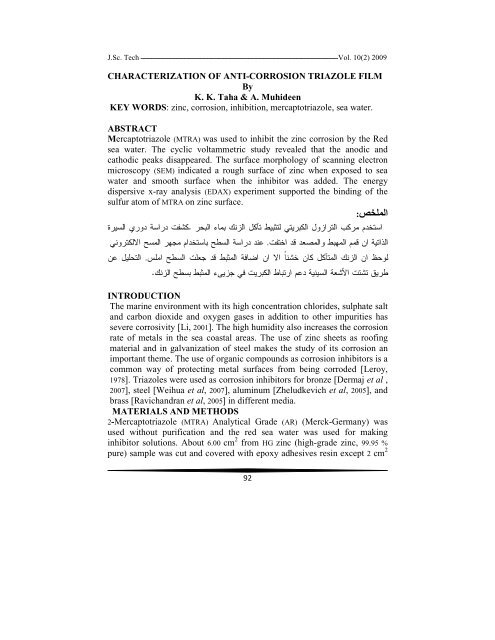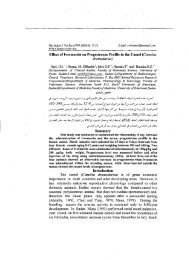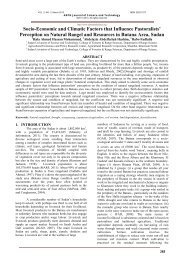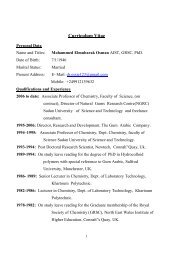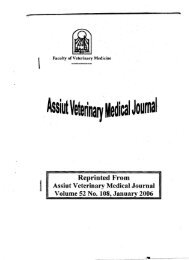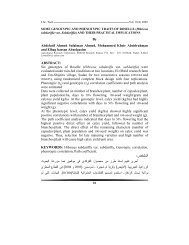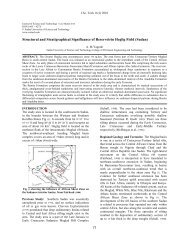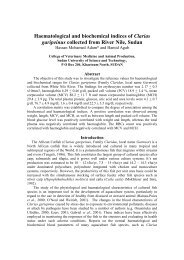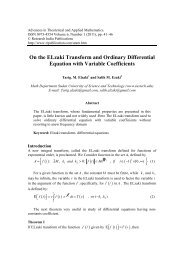CHARACTERIZATION OF ANTI-CORROSION TRIAZOLE FILM By ...
CHARACTERIZATION OF ANTI-CORROSION TRIAZOLE FILM By ...
CHARACTERIZATION OF ANTI-CORROSION TRIAZOLE FILM By ...
You also want an ePaper? Increase the reach of your titles
YUMPU automatically turns print PDFs into web optimized ePapers that Google loves.
J.Sc. Tech ـــــــــــــــــــــــــــــــــــــــــــــــــــــــــــــــــــــــــــــــــــــــــــــــ ــــــــــــــــــــــــــــــVol.<br />
10(2) 2009<br />
<strong>CHARACTERIZATION</strong> <strong>OF</strong> <strong>ANTI</strong>-<strong>CORROSION</strong> <strong>TRIAZOLE</strong> <strong>FILM</strong><br />
<strong>By</strong><br />
K. K. Taha & A. Muhideen<br />
KEY WORDS: zinc, corrosion, inhibition, mercaptotriazole, sea water.<br />
ABSTRACT<br />
Mercaptotriazole (MTRA) was used to inhibit the zinc corrosion by the Red<br />
sea water. The cyclic voltammetric study revealed that the anodic and<br />
cathodic peaks disappeared. The surface morphology of scanning electron<br />
microscopy (SEM) indicated a rough surface of zinc when exposed to sea<br />
water and smooth surface when the inhibitor was added. The energy<br />
dispersive x-ray analysis (EDAX) experiment supported the binding of the<br />
sulfur atom of MTRA on zinc surface.<br />
: ����ﻟا<br />
ﺓﺭﻴﺴﻝﺍ ﻱﺭﻭﺩ ﺔﺴﺍﺭﺩ ﺕﻔﺸﻜ.<br />
ﺭﺤﺒﻝﺍ ﺀﺎﻤﺒ ﻙﻨﺯﻝﺍ لﻜﺂﺘ ﻁﻴﺒﺜﺘﻝ ﻲﺘﻴﺭﺒﻜﻝﺍ لﻭﺯﺍﺭﺘﻝﺍ ﺏﻜﺭﻤ ﻡﺩﺨﺘﺴﺍ<br />
ﻲﻨﻭﺭﺘﻜﻝﻻﺍ ﺢﺴﻤﻝﺍ ﺭﻬﺠﻤ ﻡﺍﺩﺨﺘﺴﺎﺒ ﺢﻁﺴﻝﺍ ﺔﺴﺍﺭﺩ ﺩﻨﻋ . ﺕﻔﺘﺨﺍ ﺩﻗ ﺩﻌﺼﻤﻝﺍﻭ ﻁﺒﻬﻤﻝﺍ ﻡﻤﻗ ﻥﺍ ﺔﻴﺘﺍﺫﻝﺍ<br />
ﻥﻋ لﻴﻠﺤﺘﻝﺍ<br />
. ﺱﻠﻤﺍ ﺢﻁﺴﻝﺍ ﺕﻠﻌﺠ ﺩﻗ ﻁﺒﺜﻤﻝﺍ ﺔﻓﺎﻀﺍ ﻥﺍ ﻻﺍ ﹰﺎﻨﺸﺨ<br />
ﻥﺎﻜ لﻜﺂﺘﻤﻝﺍ ﻙﻨﺯﻝﺍ ﻥﺍ ﻅﺤﻭﻝ<br />
. ﻙﻨﺯﻝﺍ ﺢﻁﺴﺒ ﻁﺒﺜﻤﻝﺍ ﺀﻰﻴﺯﺠ ﻲﻓ ﺕﻴﺭﺒﻜﻝﺍ ﻁﺎﺒﺘﺭﺍ ﻡﻋﺩ ﺔﻴﻨﻴﺴﻝﺍ ﺔﻌﺸﻷﺍ ﺕﺘﺸﺘ ﻕﻴﺭﻁ<br />
INTRODUCTION<br />
The marine environment with its high concentration chlorides, sulphate salt<br />
and carbon dioxide and oxygen gases in addition to other impurities has<br />
severe corrosivity [Li, 2001]. The high humidity also increases the corrosion<br />
rate of metals in the sea coastal areas. The use of zinc sheets as roofing<br />
material and in galvanization of steel makes the study of its corrosion an<br />
important theme. The use of organic compounds as corrosion inhibitors is a<br />
common way of protecting metal surfaces from being corroded [Leroy,<br />
1978]. Triazoles were used as corrosion inhibitors for bronze [Dermaj et al ,<br />
2007], steel [Weihua et al, 2007], aluminum [Zheludkevich et al, 2005], and<br />
brass [Ravichandran et al, 2005] in different media.<br />
MATERIALS AND METHODS<br />
2-Mercaptotriazole (MTRA) Analytical Grade (AR) (Merck-Germany) was<br />
used without purification and the red sea water was used for making<br />
inhibitor solutions. About 6.00 cm 2 from HG zinc (high-grade zinc, 99.95 %<br />
pure) sample was cut and covered with epoxy adhesives resin except 2 cm 2<br />
92
J.Sc. Tech ـــــــــــــــــــــــــــــــــــــــــــــــــــــــــــــــــــــــــــــــــــــــــــــــ ــــــــــــــــــــــــــــــVol.<br />
10(2) 2009<br />
area at the lower part which was exposed to corrosive medium i.e. Red sea<br />
water. The zinc electrode was polished with sand paper, washed in running<br />
tap water, rinsed in distilled water before exposure to sea water and sea<br />
water containing 0.01M MTRA inhibitor. The cyclic voltamograms were<br />
obtained using an electrochemical system Autolab (Netherlands) at<br />
corrosion potentials over a potential window between –2000 and 550 mV (vs<br />
SCE) at sweeping rate of 10 mV/s. A three compartment cell with zinc as<br />
working electrode, platinum foil and saturated calomel electrode as counter<br />
and reference electrodes respectively were used for CV studies The scanning<br />
electron micrographs of the polished zinc surface after exposure to sea<br />
water and sea water containing 0.01M inhibitor were taken using vacuum<br />
scanning electron microscope model JEOL JSM-5600 LV interfaced to a<br />
computer and JSM software. The energy dispersive x-ray analysis (EDAX)<br />
studies calibration was done with respect to Co Kα = 6.9254 keV and Co Lα<br />
= 0.7763 keV.<br />
RESULTS AND DISCUSSION<br />
Organic compounds containing heteroatoms find application as<br />
corrosion inhibitors as these atoms with lone pairs of electrons are a site of<br />
their binding to metal surfaces [Leroy, 1978]. Triazoles derivatives are<br />
becoming very important both as corrosion inhibitors for metals [Wang,<br />
2001, Dermaj et al, 2007, El-sayed et al, 2007 and Taha, 2002] and as ligands<br />
especially for complexation with transition metals [Raicheva et al, 1993].<br />
The high inhibition efficiency for triazoles is attributed to their structures as<br />
proved by ab initio quantum chemical calculations [Weihua et al, 2007]. The<br />
correlation between the molecular modeling about the structure and<br />
electronic effect and inhibition efficiency was studied by Bentiss et al<br />
[2001].<br />
Figures 1and 2 show the cyclic voltammetric response of zinc in the Red sea<br />
water without and with the inhibitor. The results tabulated (Table 1) reveal<br />
an anodic and a cathodic peak at 378 mV and – 1030 mV with currents 20.48<br />
93
J.Sc. Tech ـــــــــــــــــــــــــــــــــــــــــــــــــــــــــــــــــــــــــــــــــــــــــــــــ ــــــــــــــــــــــــــــــVol.<br />
10(2) 2009<br />
mA and -76.38 mA respectively without inhibitor. The anodic peak may be<br />
due to the zinc dissolution i.e. oxidation process (Zn Zn +2 ), while the<br />
reduction peak may be oxygen reduction<br />
(O 2 + 2H 2O + 4 ē 4OH - ) taking place in presence of the inhibitor the anodic<br />
peaks vanished as well as the cathodic peaks. The disappearance of the<br />
peaks indicates that the inhibitor has hindered both anodic and cathodic<br />
reactions leading to the inhibition of zinc corrosion. These findings agree<br />
with the fact that the triazole derivative inhibitors are mixed inhibitors<br />
[Zheludkevich et al, 2005] which suppress the anodic and cathodic currents<br />
[Ravichandran et al, 2004 and [Kareema et al, 2004].<br />
I (mA)<br />
-2.5 -2 -1.5 -1 -0.5 0 0.5 1<br />
-200<br />
Fig. (1): CV for Zn in sea water<br />
94<br />
E (V)<br />
1000<br />
800<br />
600<br />
400<br />
200<br />
0<br />
-400<br />
-600<br />
-800<br />
-1000
J.Sc. Tech ـــــــــــــــــــــــــــــــــــــــــــــــــــــــــــــــــــــــــــــــــــــــــــــــ ــــــــــــــــــــــــــــــVol.<br />
10(2) 2009<br />
I (mA)<br />
-2.5 -2 -1.5 -1<br />
0<br />
-0.5<br />
-0.0001<br />
0 0.5 1<br />
E (V)<br />
Fig. (2): CV for Zn in sea water + MTRA<br />
Table (1): Anodic and cathodic peaks from cyclic-voltammograms<br />
Compound Anodic Peak Cathodic Peak<br />
E anodic (mV) I anodic (mA) E<br />
(mV)<br />
cathodic I cathodic (mA)<br />
Zn + Sea water 378 20.48 -1030 -76.38<br />
Zn +Sea water + MTRA …… ….. …… ……<br />
The SEM photographs for the corroded zinc surface and the surface after<br />
addition of inhibitors are shown in figures 3 and 4 respectively. The<br />
inhibitors function by adsorption on metal surface forming a film. The<br />
evidence for the presence of the film on zinc surface comes from SEM<br />
photographs where fine surface film is seen on the surface exposed to sea<br />
water containing the inhibitor (Fig.4) when compared to the surface exposed<br />
to sea water without inhibitor (Fig. 3). Figure (3) shows large grained<br />
morphology with deep terraces while the films obtained in the presence of<br />
inhibitors show smooth small grained surface [Taha, 2002]. A previous study<br />
[Ravichandran et al, 2005] with SEM technique supported the formation of a<br />
compact surface film on brass surface in presence of the triazole inhibitor.<br />
Kunitsugu [Kunitsugu, 2001] suggested that the inhibitors formed protective<br />
films of Zn (II) salts or complexes on zinc surface together with zinc<br />
hydroxide and oxide to prevent corrosion. Mercaptotriazole was found to be<br />
95<br />
0.0005<br />
0.0004<br />
0.0003<br />
0.0002<br />
0.0001<br />
-0.0002<br />
-0.0003<br />
-0.0004<br />
-0.0005
J.Sc. Tech ـــــــــــــــــــــــــــــــــــــــــــــــــــــــــــــــــــــــــــــــــــــــــــــــ ــــــــــــــــــــــــــــــ<br />
Vol. 10(2) 2009<br />
a strong nucleophile [Saeed et al, 2005], ], which can easily bind to the zinc<br />
ions on zinc surface.<br />
Fig. (3) SEM of zinc surface in sea water<br />
Fig. (4) SEM of zinc surface in sea water +MTRA<br />
Figures (5) and (6) are the energy dispersive x-ray x analysis (EDAX) results for<br />
zinc in sea water without and with MTRA. . When zinc was immersed in sea<br />
96
J.Sc. Tech ـــــــــــــــــــــــــــــــــــــــــــــــــــــــــــــــــــــــــــــــــــــــــــــــ ــــــــــــــــــــــــــــــVol.<br />
10(2) 2009<br />
water a high percentage of chloride can be observed together with little<br />
sulfur (Table 2). This may be attributed to the high chloride and sulphate in<br />
sea water that lead to the corrosion of zinc. The presence of low “Zn” and<br />
"Cl" contents and high "S" content on the surface suggests the bonding<br />
between the inhibitor molecules and zinc substrate. Similar conclusions<br />
were reached by Dermaj et al [ Dermaj et al, 2007] that showed the presence<br />
of sulfur on the surface using x-ray electron dispersion analysis (EDAX)<br />
when the sulfur containing inhibitor was used.<br />
Fig. (5) EDAX diagram of sea water + zinc<br />
97
J.Sc. Tech ـــــــــــــــــــــــــــــــــــــــــــــــــــــــــــــــــــــــــــــــــــــــــــــــ ــــــــــــــــــــــــــــــVol.<br />
10(2) 2009<br />
Fig. (6)EDAX diagram of sea water +zinc +MTRA<br />
Table (2): Elemental content (%) on Zn surface from EDAX experiment<br />
Medium \ Element Zn Cl<br />
Zn + sea water 49.61 47.72<br />
Zn + sea water + MTRA 2.56 21.33<br />
98<br />
S<br />
2.67<br />
76.12<br />
CONCLUSIONS<br />
1. The inhibitor 2-mercaptotriazole is a promising inhibitor for zinc in<br />
sea water.<br />
2. The cyclic voltammetric study revealed it to function as both anodic<br />
and cathodic inhibitor.<br />
3. The SEM and EDAX images supported the film formation mechanism.
J.Sc. Tech ـــــــــــــــــــــــــــــــــــــــــــــــــــــــــــــــــــــــــــــــــــــــــــــــ ــــــــــــــــــــــــــــــVol.<br />
10(2) 2009<br />
REFERENCES:<br />
1. A. Dermaj, N. Hajjaji, S. Joiret, K. Rahmouni, A. Srhiri, H. Takenouti and<br />
V. Viver, (2007). Electrochimica Acta, 52, 4654-4662.<br />
2. El-Sayed M. Sherif, R. M. Erasmus and J. D. Comins, (2007). Journal of<br />
Colloid and Interface Science, 309, 144-151.<br />
3. F. Bentiss, M. Bouanis, B. Mernari, M. Traisnel, H. Verzin and M.<br />
Lagrenee, (2007). Applied Surface Science, 253, 3696-3704.<br />
4. Karima Es-Salah, Michel Keddam, Kamal Rahmouni, Abdella Srhiri and<br />
Hisasi Takenouti, (2004). Electrochimica Acta, 49, 2771-2778.<br />
5. Kunitsugu Aramaki, (2001). Corrosion Science, 43, 1985-2000.<br />
6. S. N. Raicheva, B. V. Alekeiv and E. I. Sokolova, (1993). Corrosion Science,<br />
34, 343.<br />
7. M. L. Zheludkevich, K. A. Yasakau, S. K. Poznyak and M. G. S. Ferreira, (2005).<br />
Corrosion Science, 47, 3368-3383.<br />
8. R. Ravichandran, S. Najundan and N. Rajendra, (2004). Applied Surface<br />
Science, 236, 241-250.<br />
9. R. Ravichandran, S. Nanjundan and N. Rajendra, (2005). Anti-corrosion<br />
Methods and Materials, 52, 226-232.<br />
10. Saeed Shahrokhian and Mandra Amiri, (2005). Electrochemistry<br />
Communications, 7, 68-73.<br />
11. Wechua Li, Qiao He, Changling Peo and Baorong Hou, (2007).<br />
Electrochimica Acta, 52, 6386-6394.<br />
12. Yan Li, (2001). Bull. Mater. Sci., 24, 355.<br />
13. R.L. Leroy, (1978). Corrosion, 34 113.<br />
14. Lin Wang, (2001). Corr. Sci., 43 2281.<br />
15. K. K. Taha, (2002). Ph.D. thesis, Bangalore University.<br />
99


